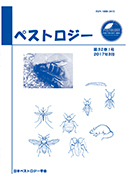Volume 20, Issue 1
Displaying 1-9 of 9 articles from this issue
- |<
- <
- 1
- >
- >|
Review
-
Article type: Article
2005 Volume 20 Issue 1 Pages 1-3
Published: June 30, 2005
Released on J-STAGE: April 10, 2019
Download PDF (6772K)
Original
-
Article type: Article
2005 Volume 20 Issue 1 Pages 5-9
Published: June 30, 2005
Released on J-STAGE: April 10, 2019
Download PDF (8548K)
Short Communications
-
Article type: Article
2005 Volume 20 Issue 1 Pages 11-14
Published: June 30, 2005
Released on J-STAGE: April 10, 2019
Download PDF (5618K) -
Article type: Article
2005 Volume 20 Issue 1 Pages 15-18
Published: June 30, 2005
Released on J-STAGE: April 10, 2019
Download PDF (7118K) -
Article type: Article
2005 Volume 20 Issue 1 Pages 19-23
Published: June 30, 2005
Released on J-STAGE: April 10, 2019
Download PDF (6682K) -
Article type: Article
2005 Volume 20 Issue 1 Pages 25-27
Published: June 30, 2005
Released on J-STAGE: April 10, 2019
Download PDF (4322K)
Technical Notes
-
Article type: Article
2005 Volume 20 Issue 1 Pages 29-32
Published: June 30, 2005
Released on J-STAGE: April 10, 2019
Download PDF (6071K) -
Article type: Article
2005 Volume 20 Issue 1 Pages 33-35
Published: June 30, 2005
Released on J-STAGE: April 10, 2019
Download PDF (5005K) -
Article type: Article
2005 Volume 20 Issue 1 Pages 37-39
Published: June 30, 2005
Released on J-STAGE: April 10, 2019
Download PDF (4966K)
- |<
- <
- 1
- >
- >|
